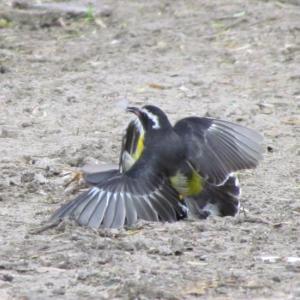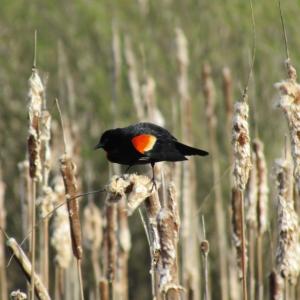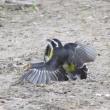Brawling in the Bird World
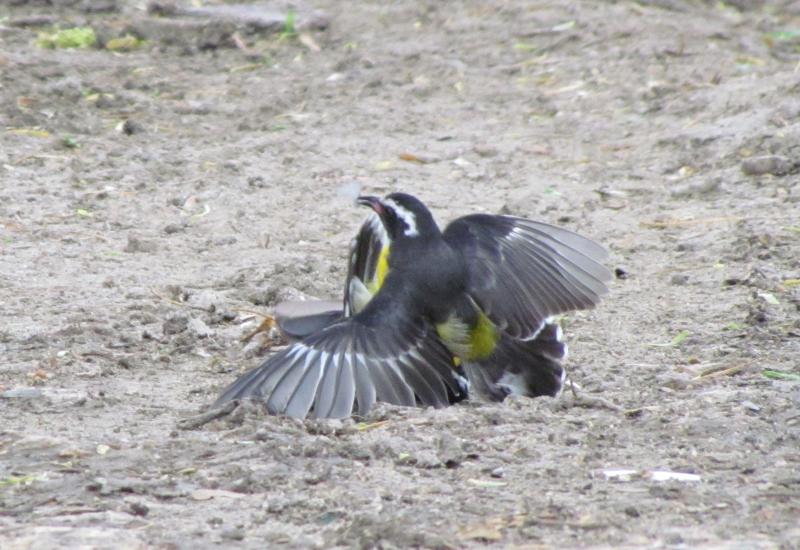 Two bananaquits in a fierce tussle on Aruba in October 2016. Note the feathers in the bill of one of the birds. Birds usually avoid such aggressive physical fighting through ritualized behaviors and singing. Courtesy of Jeff Wells.
Two bananaquits in a fierce tussle on Aruba in October 2016. Note the feathers in the bill of one of the birds. Birds usually avoid such aggressive physical fighting through ritualized behaviors and singing. Courtesy of Jeff Wells.
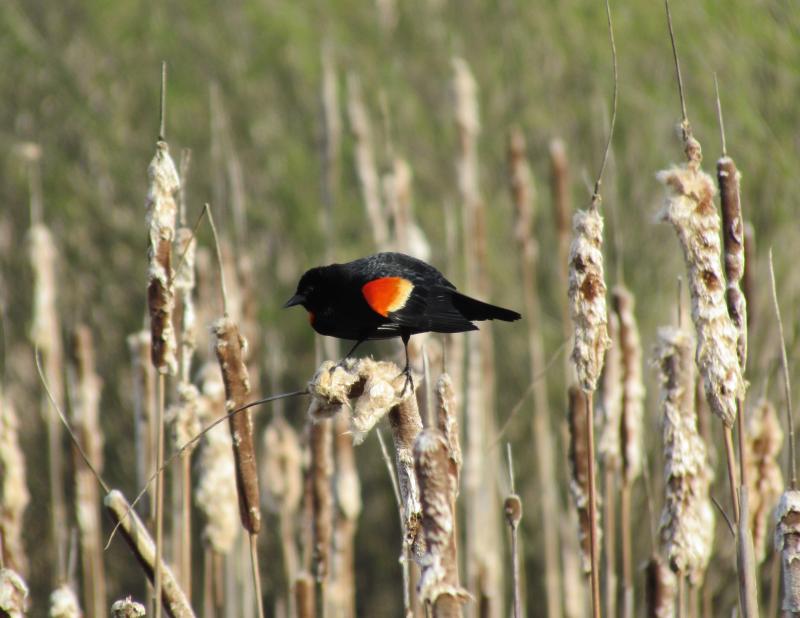 Birds like this male red-winged blackbird can send a signal to rival males by showing off their red patches on the wings while uttering their characteristic "ok-er-lee". Courtesy of Jeff Wells.
Birds like this male red-winged blackbird can send a signal to rival males by showing off their red patches on the wings while uttering their characteristic "ok-er-lee". Courtesy of Jeff Wells.
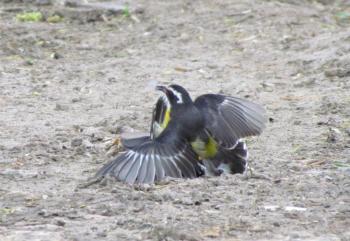 Two bananaquits in a fierce tussle on Aruba in October 2016. Note the feathers in the bill of one of the birds. Birds usually avoid such aggressive physical fighting through ritualized behaviors and singing. Courtesy of Jeff Wells.
Two bananaquits in a fierce tussle on Aruba in October 2016. Note the feathers in the bill of one of the birds. Birds usually avoid such aggressive physical fighting through ritualized behaviors and singing. Courtesy of Jeff Wells.
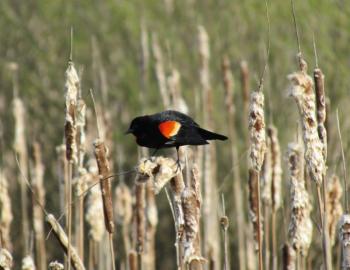 Birds like this male red-winged blackbird can send a signal to rival males by showing off their red patches on the wings while uttering their characteristic "ok-er-lee". Courtesy of Jeff Wells.
Birds like this male red-winged blackbird can send a signal to rival males by showing off their red patches on the wings while uttering their characteristic "ok-er-lee". Courtesy of Jeff Wells.
While walking the dog the other day (when a dog is walked as often as ours is, he’s bound to make frequent appearances in our column!), we heard an excited chatter of house sparrows coming from a thick bush long the roadside. Suddenly two birds popped out, fluttering chest-to-chest just over our heads. Seemingly oblivious to our presence, they descended down into a brushy tangle. A contingent of four or five more house sparrows, all calling, followed after them. We could see the two original fighters finally hop apart, and the cacophony of harsh chips stopped, too. It was like a schoolyard fight with the onlookers all shouting “Fight! Fight! Fight!” until the fighting stops (in this case, no teacher necessary to break up the fracas).
You don’t see real knock-down, drag-out bird fights that often. Aggressively pecking and clawing among birds, is, after all, a good way to get hurt, and an injury in a wild bird can drastically lower the chances of survival. Perhaps they instinctively know this.
When we talk about fighting in birds, we are differentiating fighting among individuals of the same species as compared to other aggressive interactions. The latter could include the hunting and killing of other birds as is practiced by certain raptors. There are also aggressive encounters between other species that are not involved with one species hunting another. Crows, for example, will harass eagles, hawks, owls, and ravens in an attempt to drive them away, presumably to lower the risk of themselves or their eggs or young being taken by the predator. The eastern kingbird is famous for doing the same not only to eagles and hawks but also to crows themselves.
And under the bird feeder, it’s not uncommon to see one bird jumping and pecking at another to drive it away from sought-after bird seed. At our feeders, we have a single song sparrow who, despite being probably only half the size of the house sparrows, regularly attacks and drives the larger birds away when it wants to scratch around for the seeds on the ground in the open patch surrounded by the slowly melting snow.
But direct physical combat between individuals of the same species is not something most of us see that often. Birds have ways to “fight” using ritualized signals and behaviors so that more often than not they can avoid the potentially costly physical fight. The songs of birds, while we may enjoy their tunefulness, are the ultimate signal (usually males to other male birds) that the singer has staked out a space, and any intrusions into it will be dealt with harshly. If one male is foolish enough to ignore the message of territoriality from the song of another and violates the space of the singer, then behaviors may escalate. If the singing doesn’t do the trick, the next step may be the communication of aggression through a specific ritualized behavior. Woodpeckers swing their heads back and forth. Chickadees will raise their bill straight up to the sky. Gulls may peck at the ground. All of these are behaviors that others of the same species will recognize as warnings to back off. If they don’t, feathers may fly!
Sometimes, the songs and rituals aren’t enough to stop two aggressive individuals from going at it, beak and claw. When it gets to that fever pitch, the fighters seem to ignore all the potential dangers around them, putting themselves at risk, not only from the fight but from predators, cars, and other things. We were shocked once on Aruba to see two still-singing bananaquits emerge fluttering from the bushes, their feet tangled up as they tumbled into the dirt of the parking area. We probably could have darted over and picked them up had we wanted to. Instead, we photographed and videotaped them (see sidebar). They did finally break off the fight and fly back into the bushes. We wondered if it was a grudge match that would go on for days or if things were now settled.
Although we don’t know if any other birds were watching the two fighting bananaquits in Aruba, the fight we saw between the two house sparrows just recently here in Maine was clearly being observed by other house sparrows. The so-called “audience effect” is well known in many animals, including us humans. When watched, especially be members of the same species, animals will try harder in competitive endeavors. So, a fight between birds (and other creatures) that no one is paying close attention to is more likely to get over more quickly than one a crowd has assembled to watch. Perhaps something to keep in mind, should you come happen upon a brawl!
Jeffrey V. Wells, Ph.D., is a Fellow of the Cornell Lab of Ornithology and Vice President of Boreal Conservation for National Audubon. Dr. Wells is one of the nation's leading bird experts and conservation biologists. He is a coauthor of the seminal “Birds of Maine” book and author of the “Birder’s Conservation Handbook.” His grandfather, the late John Chase, was a columnist for the Boothbay Register for many years. Allison Childs Wells, formerly of the Cornell Lab of Ornithology, is a senior director at the Natural Resources Council of Maine, a nonprofit membership organization working statewide to protect the nature of Maine. Both are widely published natural history writers and are the authors of the popular books, “Maine’s Favorite Birds” (Tilbury House) and “Birds of Aruba, Bonaire, and Curaçao: A Site and Field Guide,” (Cornell University Press).

